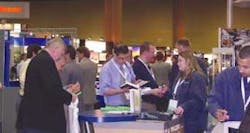Aerosense lifts some spirits
Amid general economic malaise, Aerosense 2003 (April 21–25; Orlando, FL) managed to position itself at the intersection of interesting technologies and diverse but growing markets. The boom in security and military budgets helped draw a record crowd (4200 attendees, up 13% from last year, and more than 200 exhibitors, up 30%). Not to be outdone, applications in commercial imaging and sensing were also much in evidence. Many familiar faces from telecom companies were seen walking the show floor or attending technical sessions, looking at new applications for their core technologies or intellectual property.
Most of the issues surrounding optoelectronics for homeland defense were evident at the initial meeting of the SPIE Homeland Security Technical Group. Chairman Ted Saito of Lawrence Livermore National Labs (Livermore, CA) led a meeting of more than 130 people who actively debated the focus and priorities of the group. Considerable interest focused on finding speakers or contacts who could address the requirements of the U.S. Department of Homeland Security.
The potential topics to be addressed at future meetings of the group ranged widely and were not always consistent, with some members of the audience recommending that the topics be organized by sector (for example, airport), threat (such as shoulder-fired missiles), or technology (such as infrared imaging). An initial list of topics included countering weapons of mass destruction, automated image recognition, communications security, airport security, first response, utility infrastructure protection, data synthesis/interpolation, and border security. It was clear to everyone at the meeting that optoelectronics should play an important role in homeland security, but that it is a complex arena with many nontechnical aspects driving development. The next meeting of the group is planned for Dec. 2–4 in the Washington, D.C., region.
Another world
The 25th anniversary of the Thermosense conference was held in conjunction with Aerosense. Although other infrared-related conferences have gained a larger attendance, Thermosense still contained interesting and useful nondefense-related topics. A 25-year retrospective was presented by Robert Madding of FLIR Systems (North Billerica, MA), Herbert Kaplan of Honeyhill Technical Company (Norwalk, CT), and Gary Orlove of the Infrared Training Center (North Billerica, MA). The first meeting took place in Chattanooga, TN, in 1978, in response to the energy crises and in the hopes of identifying energy waste in buildings and equipment. Orlove walked the audience through the history and development of infrared technology from the first military line scanner in 1946—which took an hour to produce an image—to the current state-of-the-art uncooled microbolometers and consumer products.
Major imaging companies such as FLIR Systems and Indigo Systems (Goleta, CA) were displaying security and surveillance cameras, along with lines of preventive and predictive maintenance cameras. INO (Sainte-Foy, Quebec) had an uncooled infrared bolometric detector array and a board-level uncooled microbolometer thermal imager. For the sensing world, Luna Technologies (Blacksburg, VA) had an interesting fiber-Bragg-grating-based distributed-sensing system that had aerospace and power-equipment manufacturing applications. A handheld bioparticle detector based on Mie scattering of light was on display from BioVigilant (Tuscon, AZ).
Note: beginning in 2004, the conference name Aerosense will be changed to the Defense and Security Symposium.

